When I was little I read a fiction book set in Uluru (also known as Ayers Rock), it had drawings of the huge red monolith and I remember thinking it looked magical.
Fast-forward 15 years and I’m visiting Australia for the first time, I couldn’t help but satisfy my childhood fascinations and pay Uluru a visit!
I went on a 3-day tour of Uluru and the surrounding areas with Wayoutback Australian Safaris and I can highly recommend the experience.
We spent 3 days learning about Aboriginal culture in Australia, hiking in stunning outback landscapes, seeing impressive rock formations and much more.
Read on to discover the day-by-day itinerary of our Ayers Rock tour, and additional information about what you need to be ready for a trip in the Australian outback.
Contents
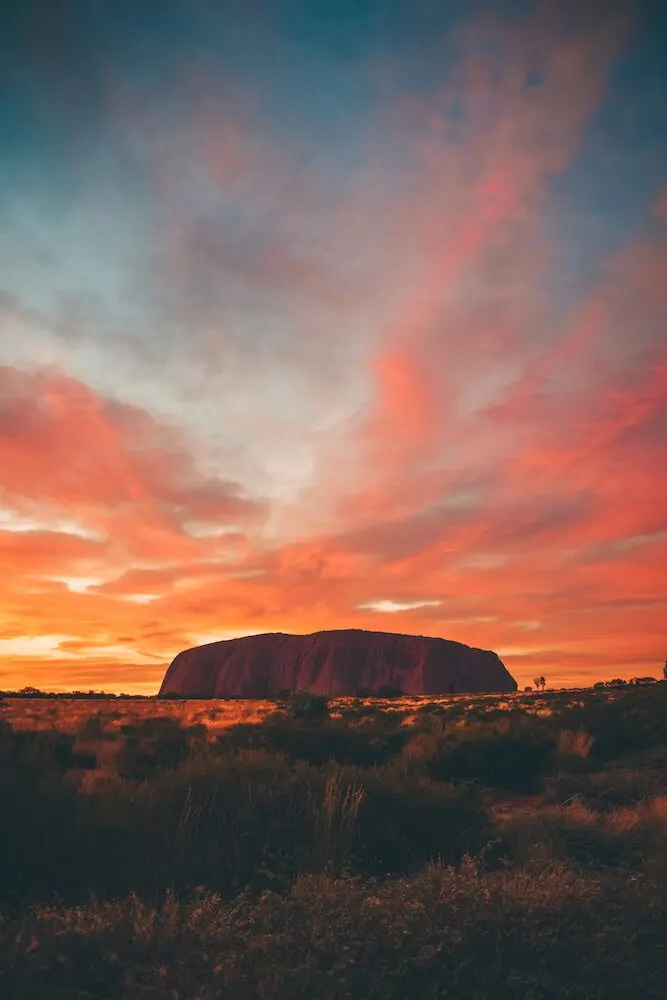
Uluru at sunrise
About Uluru & surroundings
Uluru is the original Aboriginal name of the largest monolith in Australia and the world. You might have heard it being called Ayers Rock, this is the name that the English colonisers gave it when they first came to Australia.
Either name can be used but today it’s more common and appreciated to call it Uluru. It’s located in the Northern Territory of Australia or what is known as the “Red Centre” due to red colour of the sand and rocks.
Uluru is also home to the Anangu people, who known as the world’s oldest civilisation.
Uluru is sacred to the Anangu people, which is why it is now protected by the Uluru-Kata Tjuta National Park and is listed as a UNESCO World Heritage Site.
The national park is jointly run by Australian government officials and representatives of the Aboriginal society, so as to ensure it is preserved appropriately and its history passed on.

Exploring Kata Tjuta, Australia
Our 3-day Uluru tour itinerary
Wayoutback Australian Safaris have a number of different tours both in the Northern Territory and other parts of Australia.
I would have loved to spend longer exploring Australia’s Red Centre however given our other travel plans, we decided to go for the 3 Day Goanna Dreaming Red Centre 4WD Tour, as it would enable us to see as much as possible of Uluru and the surroundings in just 3 days.
On our 3-day Uluru tour we followed the itinerary below.
Day 1: Uluru – Learn about Aboriginal culture
Our tour started with a 1PM pick up from our hotel in Yulara, the town closest to Ayers Rock airport; the Outback Pioneer Lodge.
On the first day you will receive your ticket for the Uluru-Kata Tjuta National Park, you need to hold on to this at all times as they might ask you for it if you meet a ranger.
The first stop of our tour was the Cultural Centre. Here there is a big exhibition in place that teaches you about the flora, fauna and history of this area.
The most interesting part for me was learning about Aboriginal culture and how the National Park is run today with guidance from the Anangu people.
Check out the latest prices and availability at Outback Pioneer Lodge

Exploring the base of Uluru, Australia
After visiting the Cultural Centre we drove to the base of Uluru, where we met our Anangu guide and her interpreter.
We did the Uluru base walk where we saw a number of small caves, where indigenous rituals used to be carried out and others with indigenous paintings on them.
There are lots of beautiful walks in Uluru, and the base walk is just one of them.
Our guide introduced us to Aboriginal origin stories and it was fascinating to hear about them from her, even with a interpreter translating in English.
We also learnt about Aboriginal painting methods and symbols, and what specific recurring symbols mean. We then finished our walk at Mutitjulu Waterhole, a water hole where the Anangu men used to hunt.

Our Anangu guide with some of the traditional aboriginal tools the women used
We then drove to the sunset viewing spot over Uluru. There is a big car park here and you will find a lot of other people here. Watching the sun go down and turn Uluru a fiery red is one of the biggest attractions here after all!
However most people crowd by the car park, if looking at Uluru you just walk towards the right there is a path with considerably less people. Perfect if you want to snap some photos without the crowds!
We also had a table by our 4WD with nibbles, dips and champagne, the perfect way to end our first day in the outback.
From there we drove to the campsite, where all had dinner together before going to sleep in either the tents or swag for those that felt like braving it (I wasn’t one of them).
Click here to book your Uluru 3-day tour!

Enjoying the sunset over Uluru with champagne and nibbles
Day 2: Kata Tjuta – Hike in the Valley of the Winds
On the second day we woke up at 5AM in the morning to make sure we were at the Uluru sunset viewing spot in time for sunrise.
The viewing spot is a short 5-minute drive away so you have time to get ready and have breakfast before the day starts.
Once we got there we were happy to see that the crowds of the day before at sunset had considerably diminished. We were there with only a handful of other people watching the sky around Uluru catch fire.
Once the sun was fully up we drove on to Kata Tjuta, the next stop on our 3-day Uluru tour.
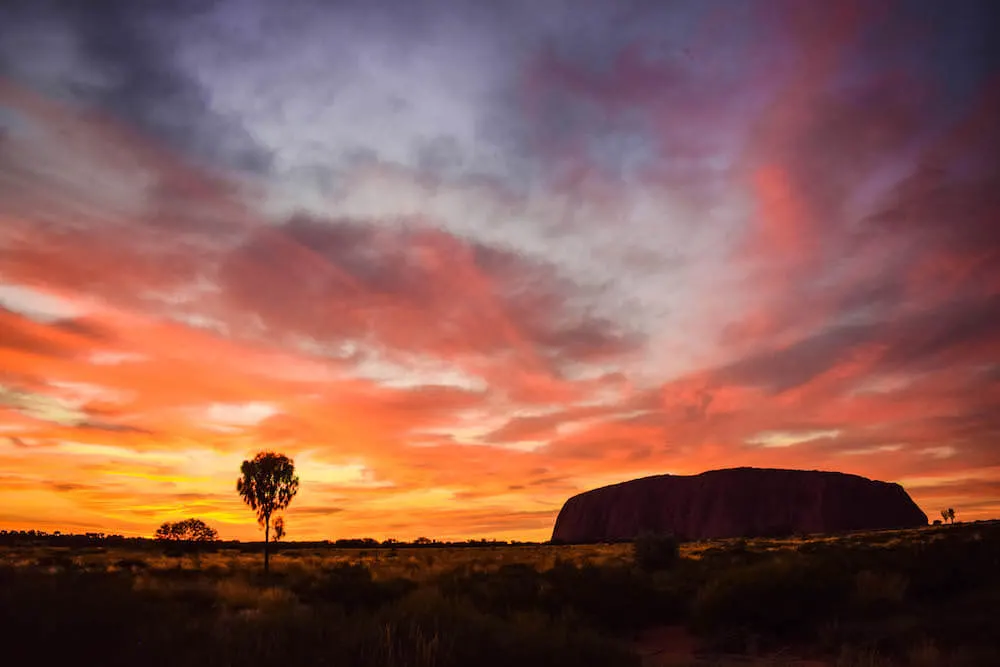
Sunrise at Uluru, Australia
I was surprised to find out about Kata Tjuta. In my ignorance I always thought of Uluru as a stand alone natural beauty, I didn’t realise there was another similar rock formation so close to it.
Our guide explained that the reason why Kata Tjuta is less known is because it is a sacred place for Aboriginal men, which means creation stories about it are not shared with tourists. Here we went hiking in the “Valley of the Winds”.
| READ MORE: 15 INCREDIBLE AUSTRALIAN ADVENTURES |

Kata Tjuta, Australia

Hiking in the Valley of the Winds in Kata-Tjuta, Australia

Hiking in the Valley of the Winds in Kata-Tjuta, Australia
The hike in the Valley of the Winds starts off on a straight path, then at one points breaks off and forms a loop, forming two possible hiking routes.
You can either hike directly to Karingana Lookout and then hike back (5.4km return, approximately 2.5 hours), or go all the way round and form a loop (7.5km full circuit, approximately 4 hours).
Being the young and dashing athletes we think we are we decided to go the longer way round. Most of the hike is pretty flat with the occasional extremely steep section.
If you can handle a 7.5km hike, I really recommend going the longer way, as part of the hike was outside of the canyons of Kata Tjuta and will give you some epic views over the surrounding landscapes.
The steepest part is the uphill climb to reach the lookout, but once you make it up, the view is well worth it!

Hiking in the Valley of the Winds in Kata-Tjuta, Australia

Hiking in the Valley of the Winds in Kata-Tjuta, Australia

The view from Karingana Lookout in Kata Tjuta, Australia
After the hike we drove back for approximately an hour to Yulara for a barbeque lunch, just what you need after a long hike!
There was also a pool at the camping spot where we had lunch so if you need to cool down after the hike it’s a great place to do so. From there we then had a long drive to Kings Creek Cattle Station; our camp for the night.
We did a few stops along the way to see Mount Connor, a mesa tableland and another important rock formation like Uluru and Kata Tjuta, and other particularities of the environment during the drive.
The camp you will stay at tonight is truly magical and will give you a true feeling of what the outback is really like.
There are no other camps, towns or other forms of civilisation for miles, making it also an amazing place for stargazing given the minimal light pollution!
We had dinner cooked on the campfire, watched the stars and then hit the hay early in preparation for the early rise the next day.
Click here for more information and to book your own Uluru 3-day tour!

Mount Connor, Australia

Our tent at Kings Creek Cattle Station, Australia
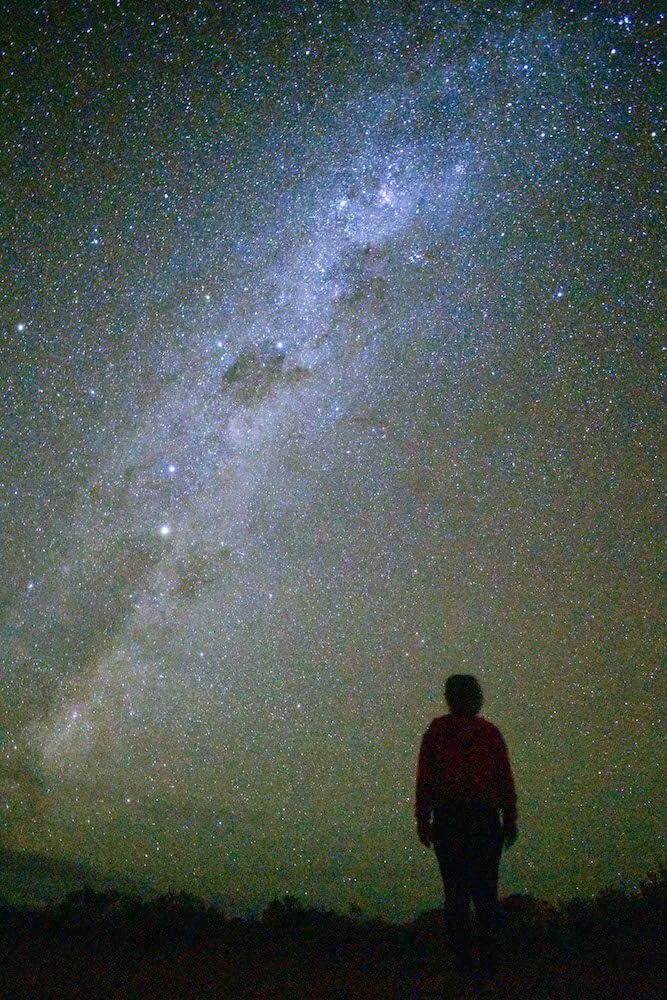
The Milky Way seen from the Australian outback
Day 3: Hike in Kings Canyon
It’s another 5AM start for day 3, so that we could make it to King’s Canyon in time to catch the sunrise and before it became too hot to hike.
There are a number of different hikes that you can do at King’s Canyon, however given that some are more than 20km long we were given two options; an easy 2.5km return trip or a 6km full circuit.
The longer loop starts with a very steep uphill walk along what is known as “Heart Attack Hill”. Yes that’s how steep it is. However even if you’re not an athlete you’ll be able to do it, if I managed it can’t be too hard really!
It’s very steep but it’s quite brief, and once you reach the summit you will be rewarded with a beautiful view over the surrounding outback.
We made it just in time to see the sun come out from behind the rocks and it set a great mood for the rest of the hike.
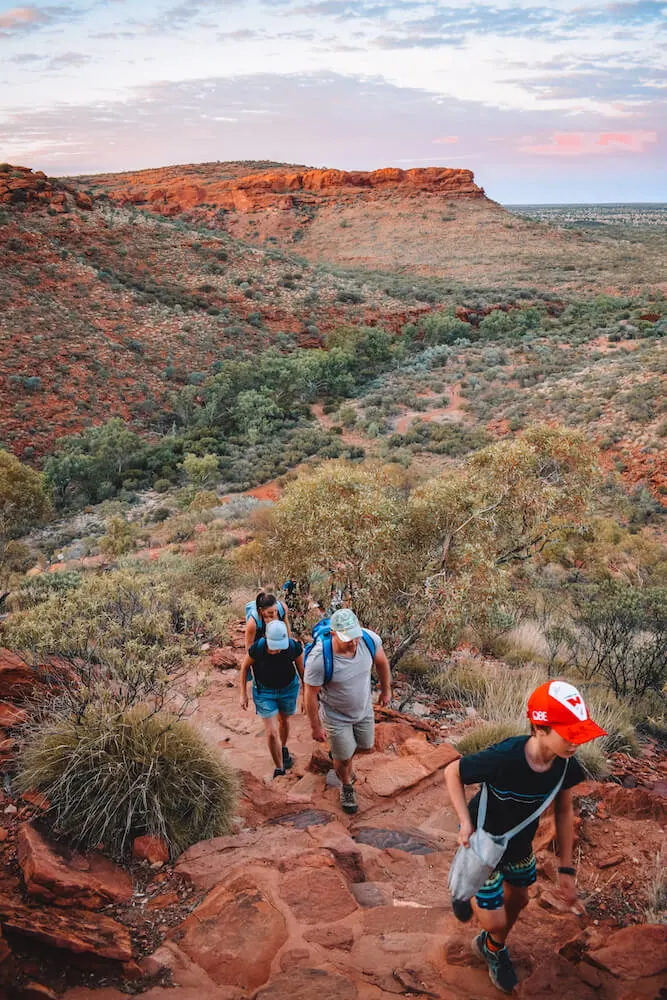
Hiking up Heart Attack Hill at Kings Canyon, Australia

Hiking in Kings Canyon, Australia

Hiking in Kings Canyon, Australia
After Heart Attack Hill the rest of the walk is pretty flat and our guide had the opportunity to tell us about the local flora, fauna and aboriginal traditions.
At a number of points during the hike we stopped to enjoy the view of the red cliffs. About half way through the hike we reached the “Garden of Eden”, an unexpected waterhole surrounded by cliffs on all sides.
We finished the hike around lunch and went back to our campsite for lunch, after which we set off for a long drive on to Alice Springs.
We did part of the driving on a typical outback road, with the occasional stops to appreciate the local flora and fauna or to try throwing a frisbee.
The tour ended around 5PM with a drop off at our hostel. If you want the tour can continue on back to Yulara.
Click here to see the latest prices and availability for your Uluru 3-day tour!

Hiking in Kings Canyon, Australia

The “Garden of Eden” in King’s Canyon, Australia

Cool rock formations in Kings Canyon, Australia
How to prepare for a trip in the outback
The Australian outback is considered one of the world’s harshest environments, and while today we have the benefits of civilisation, I still found that compared to a “normal” trip to a city or beach there were things I wish I’d known and been better prepared for.
This is an extensive list of things I think will help you prepare for a trip in the Australian outback.
Click here for more information and to book your own Uluru 3-day tour!

View over the Australian outback from Kata Tjuta
Be ready to battle the flies
One of the things I was not ready for on my outback trip were the flies. Nobody told me there would be so many flies everywhere!
From the moment when the sun comes up to when it goes back down (you get some relief at least at night!) you will be pestered by flies.
They’re like that one friend that always leans in too much when they talk to you, they have no concept of personal space.
They will fly in your ears, nose and mouth if you don’t stop them. You have two main remedies against flies:
Fly nets: These look ridiculous but they’re the only 100% effective fly repellent. They’re made of fine mesh and you wear them over your head so that they can’t get in your mouth when you speak.
The downside is that you will look a bit silly and will have to see the world through a mesh of light pink / blue / green / whatever colour you pick for your net.
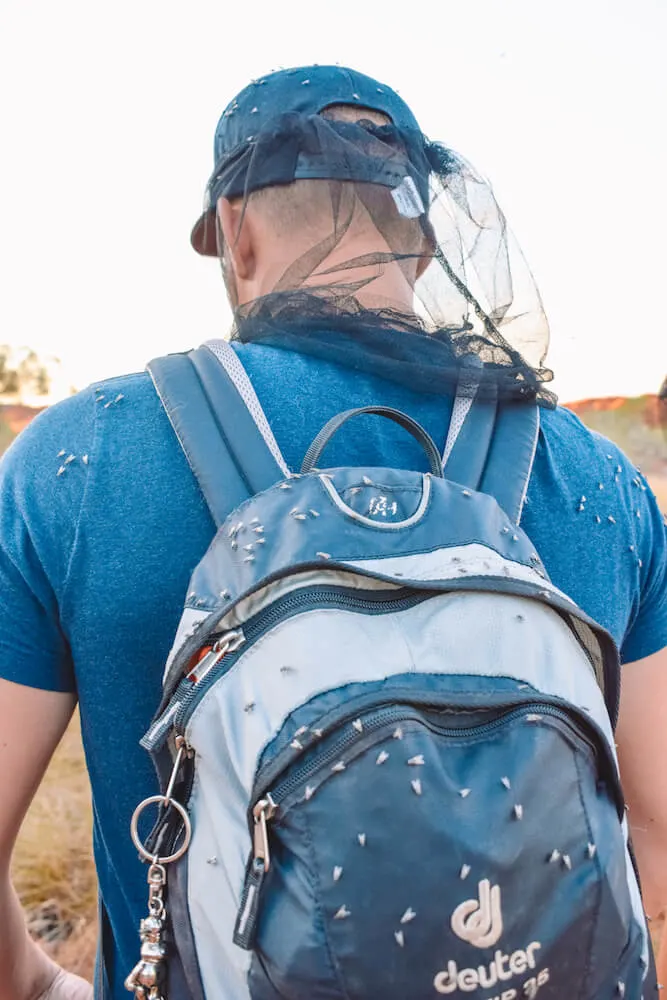
The flies will attack you as soon as they get a chance
Fly repellent roll-on or cream: This isn’t as effective as the nets but it gets pretty close. We bought a natural repellent that you apply on your exposed skin and the smell keeps the flies away (it’s not a bad smell btw)!
The only disadvantage is that you need to reapply often as it wears off quickly.
I went for the roll-on as I have the bad habit of rubbing my eyes when I’m tired and given the number of 5AMs on the itinerary, I didn’t want to be rubbing fly repellent in my face.
The cream is supposedly more effective but I found the roll-on to be enough, when a fly came too close to my face I just reapplied and they would stop coming.
All of these can be bought at the shops in Yulara or Alice Springs. You will see the shops there also sell cork hats. These are normal hats with strings with corks dangling at the end of them.
Legend says that you just shake your head and all the dangling corks scare away the flies. They don’t work. If you want one as a souvenir go for it, but don’t expect them to keep flies away.

And land anywhere on you
Don’t forget sunscreen!
I’m the kind of person that puts sunscreen on only at the beach, and even then I tend to go for factor 20 or less (what’s skin cancer compared to a beautiful golden tan right? Just kidding, that’s me trying to be funny).
In the Australian desert, make sure to bring a high SPF sunscreen and don’t forget to reapply when you need to. The sun is strong here and nobody likes sunburns or skin cancer.

Uluru at sunset
Bring water bottles
The 4WD always had a tank of fresh drinkable water on board, however you will need your own water bottles to fill up. Wayoutback recommends bringing two 1.5L bottles.
When you get off the 4WD and start hiking, don’t forget your water bottle! Hiking under the desert sun will make you sweat a lot and you will need to drink while you hike.

Hiking in Kata Tjuta with our water bottles!
Pack warm clothes
This might seem like a counter intuitive one, given that you’re going on a trip to the desert, however if you’re visiting in autumn, spring or winter you will need some warm clothes for the night.
The temperatures drop considerably at night and you will want a hoodie or long sleeved top to spend the evening in. This isn’t to say that you will need a winter coat, but just an extra layer will do.
If you need help figuring out what to pack for your trip to the Australian outback, check out my Uluru packing list.

Our camp at Kings Creek Cattle Station, Australia
Pack a small bag for the trip
If you do a tour with Wayoutback Australian Safaris they will store your luggage in a trailer in the back of the 4WD.
The luggage trailer is always accessible when you stop for the night however if you’re like me, and travelling with a huge 25kg suitcase, you might not want to lobby it up and down the stairs of the luggage trailer and into a small tent.
I found it easier to pack the things I needed for 3 days in a backpack so I could keep those with me in the bus, and I just put the luggage in the trailer at the tour pick up and took it back at the end of the tour.
Click here for more information and to book your own Uluru 3-day tour!

The Wayoutback Australian Safaris 4WD vehicle we did the 3-day Uluru tour with
Final thoughts on our Uluru 3-day tour
Have you been to Uluru? How did you find it? Let me know in the comments below!
Visiting Uluru was a magical experience for me, one of the highlights of my Australia trip and something I think everyone should add to their Australia itinerary.
I was a bit concerned I would be doing a huge trip to get there and then feel like it was all “just for a big rock in the middle of the desert” but it was so much more than that.
Learning about aboriginal culture was fascinating, the hikes we did were amongst my favourite ever and the landscape was unlike anything I had ever seen before.
If you get the opportunity, I highly recommend doing a 3-day tour of Uluru.
Looking for more Australia tips? Check out my travel guides:
- Is the Bondi to Coogee Coastal Walk the most beautiful walk in Sydney?
- Swimming in the Noosa Heads fairy pools
- Fraser Island 3-day tour review
- How to spend a weekend on the Great Ocean Road
- The best day trips to Whitehaven Beach & the Whitsunday Islands
- How to spend 3 awesome days in Sydney
- 15 most Instagrammable places in Sydney
- Day trip to Blue Mountains from Sydney
- Daintree Rainforest – the ultimate Cairns day trip
- Everything you need to know to plan the perfect Australia road trip
- Cairns to Brisbane 2-week itinerary
- Discover the Great Barrier Reef
- Best things to do in & around Cairns
Enjoyed reading about our Uluru 3-day tour? Pin it!





gpks00
Wednesday 30th of January 2019
Thanks for the information. It looks like that tour costs $860 AUD on 1/30/19. Kind of a high price. I will look for other tours and compare itineraries and read others reviews. Your info make me wonder if there is some similar type of fly repellent that you could sort of pre-soak your shirt in that would also help keep them away. Thanks for the post and you have some great photos!
Greta
Monday 4th of February 2019
The tour I did was a bit more expensive as it was in a smaller 4x4 coach and sleeping in tents, the same company does bus tours sleeping in the swag (under the stars) which are cheaper. Don't know about a fly repellent for clothes, I found the roll-on was fairly effective! Glad you liked my post & photos, hope this helps in planning your trip! :)
Small Towns in Australia Worth Visiting (and a Couple of Slightly Bigger Ones) - Birdgehls
Wednesday 11th of July 2018
[…] population of less than 900 people. It is also a popular tourist destination, as it is where most Uluru tours start from and it’s where all the area’s campsites and hotels are […]
Helena
Saturday 2nd of June 2018
Gorgeous photography! And you've enlightened me, didn't realise there was quite so much to do around the rock too :) Enjoyed the read!
Greta
Saturday 2nd of June 2018
Thanks, glad you enjoyed the post! And I know, I had no clue till I went there! (should've done more research before haha)
Christie
Saturday 2nd of June 2018
I visited the Outback a couple years ago and LOVED it! Uluru is so beautiful and I loved Kings Canyon as well. Your photos are great and are making me want to get back to Australia asap!
Greta
Saturday 2nd of June 2018
Thanks so much, glad you enjoyed it! Visiting the outback and Uluru was my favourite part of my Australia trip!
Carmelatte
Saturday 2nd of June 2018
If there was only a word to describe those photos... Is it magic?
Beautiful journey!
Greta
Saturday 2nd of June 2018
Thanks, it really is a magical place!